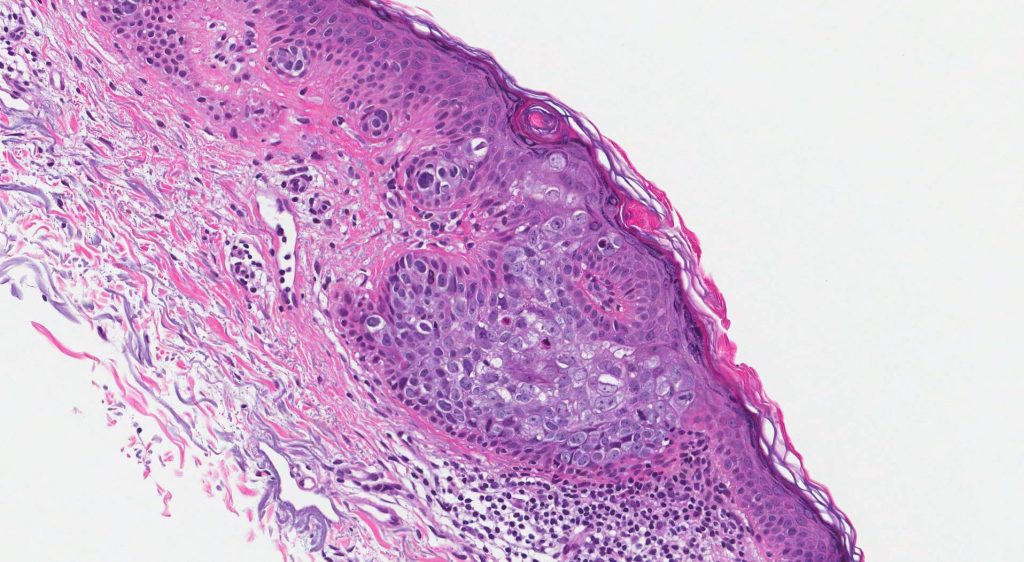Know the 3 types of skin cancer:
- Basal Cell Carcinoma
- Squamous Cell Carcinoma
- Melanoma Carcinoma

Bowen's Disease
Bowen’s disease, also known as squamous cell carcinoma in situ, is a type of skin cancer that affects the outermost layer of the skin. It is characterized by the appearance of red, scaly patches on the skin, which may be flat or slightly raised. The patches can also be itchy, and sometimes bleeding can occur. Bowen’s disease most frequently occurs in areas of the skin that have been exposed to sunlight for prolonged periods, such as the face, scalp, neck, arms, and hands. However, it can occur anywhere on the body. Bowen’s disease is more common in people over the age of 60, but it can also occur in younger individuals.
Bowen’s disease is considered a pre-cancerous condition, meaning that if left untreated, it has the potential to progress into invasive squamous cell carcinoma. Therefore, it is important to seek medical attention if you notice any changes in your skin.
How is Bowen's Disease Diagnosed?
To diagnose Bowen’s disease, a doctor will typically conduct a physical examination of the affected area, looking for characteristic signs such as the presence of lesions or plaques. A biopsy may also be performed, in which a small sample of the suspicious tissue is removed and examined under a microscope to determine whether cancer cells are present.
Additional tests may be ordered if the cancer is suspected to have spread beyond the skin, including blood tests, imaging studies such as CT or MRI scans, and sentinel lymph node biopsy to check for the presence of cancer cells in the lymph nodes. It is important to seek medical attention if you notice any unusual changes in your skin, such as persistent red or scaly patches, as early detection and treatment can improve the prognosis for the disease.
How Is Bowen's Disease Treated?
Treatment for Bowen’s disease depends on the location, size, and thickness of the patches. In some cases, surgery may be necessary to remove the affected skin. Topical medications, such as creams or gels, may also be prescribed to help manage symptoms and reduce the risk of spreading the cancer.
Superficial radiation therapy has emerged as a preferred treatment option for Bowen’s disease due to its high success rate and minimal side effects. This type of therapy involves directing a beam of radiation at the affected area, which damages the cancerous cells and prevents them from multiplying. Unlike surgery, superficial radiation therapy is non-invasive and does not require anesthesia, making it a more comfortable option for patients. Additionally, the treatment is generally completed within a few weeks, and patients can return to their normal activities immediately afterward. While there are various treatments available for Bowen’s disease, superficial radiation therapy has proven to be an effective and safe treatment option, and is often preferred due to its ease of use and fewer side effects.

What Causes Bowen's Disease?
Bowen’s disease is typically caused by exposure to sun or ultraviolet (UV) radiation. Prolonged exposure to the sun can damage the skin cells and cause DNA mutations, leading to the development of abnormal cells that can grow out of control. Other risk factors that can contribute to Bowen’s disease include smoking, a weakened immune system, and certain medical conditions, such as human papillomavirus (HPV) infection. The disease typically appears as a scaly red or brown patch on the skin that can be itchy or painful and may bleed or crust over time. Prompt medical attention is essential to manage Bowen’s disease and prevent it from spreading to other parts of the body. Treatment options may include surgery, radiation therapy, or topical medications, depending on the severity and extent of the condition.
What should I do if I suspect I have bowen's diseaser?
If someone suspects that they have skin cancer, the first step is to schedule an appointment with a dermatologist. They are experts in detecting and diagnosing skin cancer. During the appointment, the dermatologist will examine the skin closely and may take a tissue sample for a biopsy in case a suspicious mole is found. The biopsy results will help determine whether the mole is cancerous or not.
If a mole is confirmed to be cancerous, the dermatologist will discuss treatment options with the affected person. The treatment option usually depends on the type of skin cancer, the size, and location of the tumor. Treatment options may include surgical excision, radiation therapy, or chemotherapy. It is also important for someone who suspects they have skin cancer to practice good sun protection habits, such as wearing protective clothing and sunscreen daily and avoiding prolonged sun exposure. Overall, early detection and treatment of skin cancer can significantly improve a person’s chances of a positive outcome and prevent potential complications.